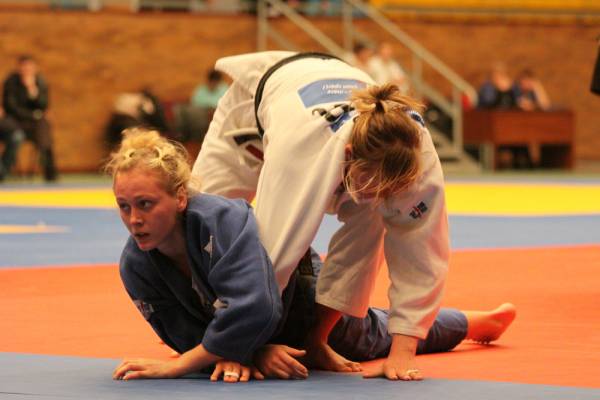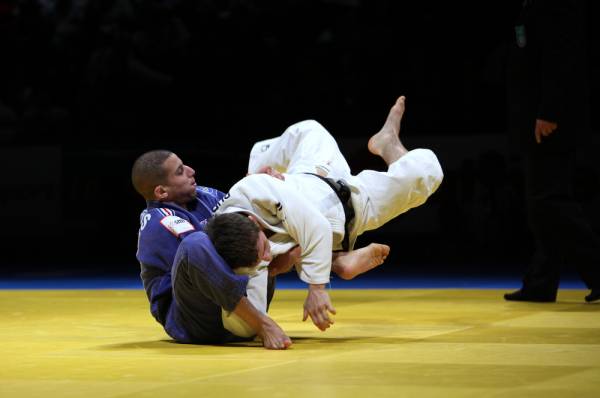So far in this five-part series I’ve gone over the basic strength and conditioning requirements of all judo players, as well as specific training programs for three types of athlete. Along the way you may have had some questions. I have collected questions here in this final installment in order to provide answers. Feel free to add additional questions into the comments below and I will do my best to answer
Strength Training for Judo
Part 1 – Training Grip and Cardio
Part 2 – Workouts for the Turner
Part 3 – Workouts for the Charger
Part 4 – Workouts for the Grappler
Q: Why aren’t there Olympic Lifts?
A: The simple answer is, I don’t like them. Sorry. It’s not that the Olympic lifts are not useful, but rather, I don’t like the technical aspects of them. To master the Olympic lifts (and I truly mean master, not heave around barbells looking like an idiot) it takes many hours of work. There truly is a skill in the matter. Olympic lifting is its own sport because of this. Judo players need to maximize their time and energy focusing on the technical aspects of judo, not weight training.
Q: What about off-balanced/BOSU work?
A: Functional fitness is what you’re talking about. And frankly, in most ways I don’t agree with it. You are in the weight room to strengthen the body. Barbells and dumbbells place enough stress on the body without placing you on a Jell-O-like pad to do things. The stabilization effects of normal training will be more than enough for the body.
Q: What about the [insert name of] exercise?
A: Again, this isn’t the “ultimate” program. There is no “ultimate” program. Anyone who states as such is hawking snake oil. The only way to classify a workout as “ultimate” is what is best for a particular athlete at a particular time. Needs will change. An athlete’s body will change, if only due to age and injuries (injuries are a certainty in judo, not a possibility). This is merely a program that I have seen get good results for athletes of this type.
Q: Why aren’t you using a Prowler/sled?
A: Man, I love sleds. I do. As a former football lineman, I spent more time pushing sleds, cars, or other types of implements during hot South Carolina summers in high school than should probably be considered healthy. However, not everyone has access to these devices. Perhaps your gym doesn’t have them. Perhaps you don’t have a place to train with them. Either way, this program was designed with a minimum of equipment that cannot be easily thrown into a normal gym bag and taken to even the most bare of gyms (except for Planet Fitness, which just sucks.)
Q: Should I use a belt/wrist wraps/straps in the workout?
A: Really, I think it’s a matter of choice. I personally believe the use of such items can be helpful, especially a good weight belt. Sorry, but the core and low back of a judo athlete takes enough of a beating that some assistance can be useful. Same with the wrists and hands. I would rather challenge the body using these assistors and strengthen the important muscles of the legs, hips, and chest, than be held back by a bum pinky finger or other item. That being said, do not use them as a crutch. Belts should be used only for exercises that vertically load the spine, and when you are going heavy (the 5RM sets, basically). Straps and wraps the same. Unless you have an injury, you shouldn’t be using wrist straps to help with your grip until you are nearing your training max levels.
Q: Why are there so few machine exercises?
A: Again, I designed this to be used by someone with limited access to equipment. Even when I do note a machine-based exercise (for example, lat pulldowns), it is easily replaced with a non-machine exercise (pullups). If you have access to these machines, and you want to use them as an assistance exercise, go ahead. But, the main exercises (the 5RM) should still be free weight. No, a squat machine, no matter how good, can truly replace a squat. A Hammer strength chest press cannot replace a good bench press. That being said, if that is all you have access to, then use it.

Q: What about changing rep schemes? Pyramids? 5/3/1?
A: Good ideas. Not saying they aren’t. But, these programs are designed as your baseline. They’ll give you the foundation to work from later. Pyramids, 5/3/1, etc. are good ideas to be used during the non-competitive season, and I use them on occasion. But going into a competition, you don’t need the added stress from a changing program on your body. In deciding the rep scheme, the main exercise is going to be in the 5 repetition area, which is still mostly maximum strength, the main element that this program is trying to train.
Q: What is the meaning of “5RM” in the set guidelines?
A: 5RM means to work up to the athlete’s 5 repetition maximum, using as many sets as needed to get there. I generally use the “big plate-10 kilos” rule. If an athlete’s 5-rep max is above a “big” (20 kg) plate plus 10 kg, you start at the big plate. If the 5-rep max is lower than this, you start at the 10 kg mark below the big plate.
Here are two examples. Let’s say that the athlete’s 5RM is 130 kg. This is 2 “big” plates plus a 15 kg plate on each side. So, the sets would break down like this:
- Empty bar x 15 (warmup)
- 60 kg (1 big plate per side) x 8
- 100 kg (2 big plates per side) x 5
- 110 kg x 5
- 120 kg x 5
- 130 kg x 5
Notice that most of the jumps are of 10 kg increments. This is because the 5RM exercises tend to fall into the “big muscle” category, and a jump of 10 kg (a 5 kg plate) per side is acceptable.
Now, let’s look at the same, but the 5RM is now 150 kg (3 big plates plus a 5 kg plate per side). As noted before, the “work sets” would then start at 120 kilos (2 big plates plus a 10 kg plate). So, we have:
- Empty bar x 15
- 60 x 8
- 100 x 8
- 120 x 5
- 130 x 5
- 140 x 5
- 150 x 5
Athletes should try, at least once a month, to go and push for a new 5RM. In these weeks, the use of 2.5 or even 1.25 kg plates is acceptable.
If an athlete is tired, worn out, or just plain doesn’t have it that day, and cannot reach their normal planned 5RM, then stop the movement wherever the athlete needs to. It is better to have good quality sets, and perhaps a couple of fewer kilograms on the bar, then to be a slave to a workout log and get hurt and lose training time on the mat.
Q: How long should I be on this program?
A: For a recreational or semi-serious player, this program can be followed for most of the year. I would recommend having at least two break periods planned into the yearly schedule of at least one week. If an athlete needs more, give them more. Just make sure a deload week doesn’t turn into a detraining month and a half.
For a very serious player, or someone with a longer competitive season, the program can be seen as a pre-season program, with an in-season program being a much-shortened version (that can be released later). Especially if the athlete is someone training more than two times a week, a shortened program is necessary to prevent overuse injuries.
Q: What about cycling programs?
A: This template is flexible. In addition to planned deloading weeks, the variations are numerous. An athlete can switch from the three day to a four day template. They can substitute out variations of presses, squats, and rows. Even playing with rep schemes is good. If the athlete wants, do a month of going for 3 rep maxes (3RM) or 8RM instead of the templated 5RM. These variations can make a great change up to a long off-season.

Q: What if it hurts?
A: Are you hurt, or are you injured? Just kidding. If by hurt you mean injury hurt, and not my legs are sore for the first two weeks hurt, then stop doing the exercise. Try a variation, find something that works the same muscles that doesn’t hurt. If it’s a muscle injury, take it easy. Train around the injury as much as you can.
Q: What other programs can/should I do for [insert length of] time frame?
A: Depends on the time frame. I personally am a fan of the ideas of Tudor Bompa, and using training cycles to best prepare athletes for a competition. This program would be the type of program used for a maximum strength cycle, or a mixed cycle (max strength and hypertrophy). For an adaptive cycle or a max power cycle, or an in-season cycle, changes to the program must be done.
Q: My athlete likes elements of all three styles you mention, it seems. What do I do?
A: No judo athlete is going to be a “pure” stylist. Robert Van DeWalle, perhaps the epitome of a Grappler, was also known for his strong hip throws, a Turner technique. Many Turners will also have strong o-uchi garis, a Charger technique. The key for the coach is to look at the most preferred techniques of the athlete, and use that as the basis for a style assignment. And of course, customization of the templates can also be used to address the crossover elements.
Strength Training for Judo
Part 1 – Training Grip and Cardio
Part 2 – Workouts for the Turner
Part 3 – Workouts for the Charger
Part 4 – Workouts for the Grappler
Photos courtesy of Shutterstock.






